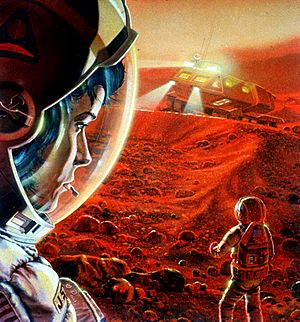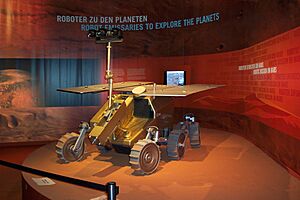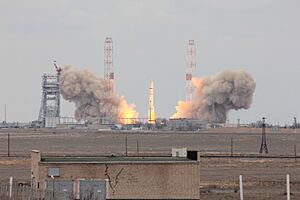Aurora programme facts for kids
The Aurora programme was a big plan by the European Space Agency (ESA). It started in 2001. The main goal was to explore our Solar System. Scientists wanted to use both robotic spacecraft and human spaceflight. They hoped to find signs of life on other planets. The Aurora programme finished in 2025.
Contents
Understanding the Aurora Programme
Countries that joined the Aurora programme committed for five years. After that, they could change their involvement. In the beginning, the programme planned for two types of missions. These were "Flagship" missions and "Arrow" missions. Flagship missions were major explorations. Arrow missions tested new technologies. These included vehicles that could re-enter Earth's atmosphere. They also worked on ways to slow down spacecraft using a planet's atmosphere.
Why was Aurora Important?
The Aurora programme was part of Europe's plan for space. This plan had three main goals. First, to explore the solar system and the universe. Second, to create new technologies. Third, to inspire young people in Europe. It aimed to get them interested in science and technology. A key idea was that technology and exploration work together.
Missions of the Aurora Programme
The first ten years of the programme focused on robotic missions. These missions used robots to explore space.
Flagship Missions: Big Explorations
ESA called some Aurora missions "Flagship" missions. These were the most important ones.
- ExoMars: This was the first Flagship mission. It was a robotic mission to Mars. It launched in 2016. It included an orbiter that circled Mars. It also had a lander that went down to the surface. This lander was called Schiaparelli.
- Rosalind Franklin Rover: This rover was part of the ExoMars mission. It was designed to explore Mars. Its launch is planned for 2028.
- Mars Sample Return: This mission aimed to bring samples from Mars back to Earth. It was planned for the mid-2020s.
- Human Mission to Mars: A mission to send humans to Mars was planned for the mid-2030s.
Arrow Missions: Testing New Tech
Arrow missions were about testing new technologies. These technologies were needed for the bigger Flagship missions.
- Earth Re-entry Vehicle: This mission tested how a spacecraft could safely return to Earth. This was important for the Mars Sample Return mission.
- Mars Aerocapture Demonstrator: This mission tested how to use a planet's atmosphere to slow down a spacecraft. This helps it get into orbit. This technology is called "aerobraking" or "aerocapture."
Timeline of Aurora's Plans
Here are some of the key plans from the Aurora programme:
- 2014: Tests for human mission technologies. These tests helped with building things in orbit. They also worked on life support systems for astronauts.
- 2016: The ExoMars mission launched to Mars. Its goals included studying Mars's surface. It also looked for signs of past or present life.
- 2026: A robotic mission to Mars was planned.
- 2030s: The first human mission to Mars was planned. This would be a complex mission.
See also




